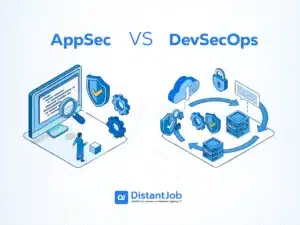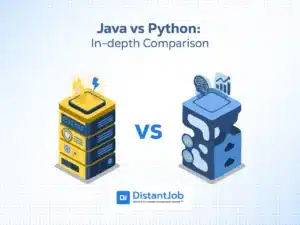Python vs. JavaScript for Web Development is like a duel of titans. Both are very popular, practical, complete, versatile, efficient, and flexible. But which is best for developing a web application? Can Python replace the almighty Javascript for web development? The simple answer is no.
JavaScript dominates client-side programming because all modern web browsers include a built-in JavaScript engine, allowing code to run directly in the user’s browser. This native support makes JavaScript essential for creating responsive, interactive user interfaces through front-end frameworks like React, Angular, and Vue.
Python, although incredibly versatile, doesn’t have browser-native support and can’t directly replace JavaScript in client-side contexts. Instead, Python shines on the server-side, powering backend logic, database interactions, complex data processing, and advanced features such as AI, automation, and machine learning, especially when paired with frameworks like Django or Flask.
In this article, we’ll dive deeper into the technical strengths and ideal use cases of each language, providing clarity to help you pick the optimal tech stack for your web application.
5 Key Differences between JavaScript and Python
When deciding between JavaScript and Python for web app development, consider their primary strengths: JavaScript excels in creating dynamic, interactive front-end user interfaces, making it ideal for client-side interactions. Python, however, shines in backend development and is especially suited for complex data processing, artificial intelligence (AI), machine learning, and automation tasks.
Let’s dive deeper into their key differences:
1. Performance and Scalability
Performance is how the web app runs in that given language; Scalability refers to how many users can run the app at the same time. We are comparing both in the Python vs JavaScript for web development context.
While it is single-threaded, JavaScript works with non-blocking I/O and asynchronous programming. It allows JavaScript to handle tasks efficiently, allowing responsive and interactive web applications. In summary, JavaScript is tailored for web development.
Python may be not very scalable due to the Global Interpreter Lock (GIL), which limits the execution of concurrent threads (it cannot run several threads at the same time). In other words, Python doesn’t perform in web apps as well as JavaScript, except when your app deals with complex math problems, computational science or AI.
2. Community and Ecosystem
A language community is a group of people who use the same language to program and share a desire to learn or improve their skills. They develop libraries and frameworks to facilitate the programming of their chosen programming language. The set of libraries and frameworks for a language is called ecosystem.
Both JavaScript and Python have a large, well-established community and rich ecosystems in libraries and frameworks, which can accelerate the development and reduce costs for web development.
JavaScript has a large range of popular libraries like React, Angular and Vue.js, which makes development easier.
Python also had a huge collection of libraries, like Pandas for analytics, Django for web development and Numpy for computational science (a field of study that uses computers and mathematics to solve complex problems)
3. Hiring Costs
While checking on February 16th, I found out how much both Python and JavaScript Developers make in the United States on Indeed.
The average salary for a Python developer in 2025 is $123,492 per year in the United States. 1.5k salaries reported, while a JavaScript developer’s salary is $114,773 per year in the United States. 167 salaries reported, updated on February 8.
By the time I write this article, a JavaScript developer is slightly cheaper.
4. Talent Availability
How many Python and JavaScript Developers have been in the world over the years? Inapps compared many surveys and here is what they have found out.
- Python: 8-10 million. Python is an easy, versatile language, beginner friendly and it is expected to raise its ranks for the next few years.
- JavaScript: 12-13 million users. According to Inapps, the reason for so many users is that JavaScript is “driven by web advancements, progressive web apps, and serverless functions”.
5. Development Costs
Now, considering Performance, Stability, Ecosystem, Hiring Costs and Talents Availables, we can properly address the development costs.
When it comes to development costs, the main thing about Python is that it is easier to learn. You can develop a web app faster than with JavaScript to learn, which can reduce costs. However, Python devs charge slightly more.
For JavaScript, because you have a larger pool of talent who are cheaper to hire, the web app will take its time to develop, which can be expensive at first, but as soon as it is launched, you can plan your scalability and earn more in the long run.
When to Choose JavaScript
Choose JavaScript when your project requires:
- a top-notch performance for users, especially at front-end,
- scales well,
- cheaper hires from a larger pool
Ideal for projects that require high front-end interactivity, full-stack development, and universal browser compatibility (while you may have to optimize it for different browsers). It is essential for creating interactive and dynamic web pages. It runs in the user’s browser (client-side) and allows you to add interactive behaviors to HTML elements and style web pages. JavaScript is essential for front-end development, handling the user interface and user experience. Additionally, with Node.js, JavaScript can also be used on the back-end.
When to Choose Python
Choose Python when your project requires:
- proper tools for computing science, data analysis, machine learning or artificial intelligence,
- capability for faster release,
- no need for scalability, like an app for company use only.
Suitable for projects focused on the backend, data analysis, automation, machine learning and scientific applications. It is primarily used in backend development, which is the part of web development responsible for creating the elements that users don’t see, such as the server side of an application. Python is also suitable for data analysis, automation, and artificial intelligence. Frameworks such as Django and Flask allow developers to use Python to build server-side logic, access databases, and manage the functionality of a web application.
JavaScript or Python? Take the Quiz to Find Your Ideal Web App Language
Whether you need JavaScript’s high-performance, interactive front-end capabilities or Python’s robust backend support for data analysis, machine learning, and rapid deployment, we create a quiz for you which is designed to guide you through this decision. Give it a go:
Is it possible to use both Python and JavaScript altogether?
Yes, it is possible and often advantageous to combine the two languages. Python can be used on the backend for data processing and server-side logic, while JavaScript is used on the frontend to create the user interface. Tools like Node.js and PyExecJS make this integration easier.
Additional resources:
- PyScript: Allows you to run Python code directly in the browser, but is still in early development.
- WebAssembly (WASM): Allows you to run code from other languages, including Python, in the browser, but usually requires JavaScript for the calling code.
JavaScript vs Python for Web Development: How to know which is best for your needs?
To decide between JavaScript and Python for web development, start by determining whether the project requires high performance, security, and scalability, or whether rapid development and data science integration are more important.
Then, assess your team’s familiarity and experience with both languages. If your team already has expertise in one language, it may be more feasible to stick with that language.
The third step is comparing the costs of hiring developers, the estimated development time, and the long-term maintenance costs.
If possible, build a prototype in both languages to compare ease of use, performance, and suitability for your specific project.
But, hey!
Maybe, despite all this knowledge, you haven’t decided which programming language is the best for you.
Or, maybe, you already had decided on it, but you still don’t know how to find a developer that can suit best for your needs.
And, for either case, that is okay, I feel you.
This is why I would like you to contact me now. Let’s have a chat, me and you. Tell me about your company, tell me about your needs, tell me about your company culture and you will get the best developer.
I will figure out which is the best programming language for you, and I will headhunt the best Javascript or Python expert for you.
You would get extremely lucky if an outsourcing company lent you its best hire; and all those online marketplaces will push on you all these freelancers who are not interested in your business, but in themselves.
In the meanwhile, I will find for you the best JavaScript or Python developer in the whole entire world, that one who matches all your company’s needs.
What of those would be better for you? The best hire in town or the best on planet Earth?
We are so confident that we can find your best remote hire in the world that, if you are not satisfied in three months, we return your money, no questions asked.
Are you curious to know more? Contact me. See you soon.





